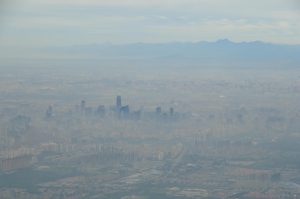Since the autumn, a series of polluted “hazes” in cities across China – and discussion of that now ubiquitous term for fine particulate matter, PM2.5 – have attracted widespread public attention. So too has the official response: while urban air pollution fast became a focus of public anger, the Ministry of Environmental Protection (MEP), which is responsible for monitoring air quality, took the opportunity to show its sluggish and bureaucratic side.
In Beijing, the gulf between reported air quality and the reality experienced by city residents became a sharply divisive issue. At the same time, air quality data from unofficial sources spread rapidly via new modes of communication. That people now disregard government data points to the dissatisfaction they feel regarding the state’s environmental protection apparatus.
But a few recent events began to mollify people. First, premier Wen Jiabao stressed that environmental monitoring data must tie in more closely with people’s actual experience. Then, vice-premier Li Keqiang called for preparations to start for the monitoring of PM2.5, which specifically are particulates measuring 2.5 microns in diameter. Finally, the MEP joined the table: at the Seventh National Conference on Environmental Protection, minister for environmental protection Zhou Shengxian announced a detailed timetable for the monitoring of PM2.5 and ozone.
In 2012, China will begin monitoring these two pollutants in Beijing, Tianjin, Hebei province, the Yangtze River Delta, the Pearl River Delta and other key regions, municipalities and provincial capitals. By 2016, the entire country will monitor PM2.5. Zhu Jianping, deputy director of the MEP’s environmental monitoring department, said that this plan presents no technical problems: in principle, monitoring PM2.5 is no different from monitoring the larger particulates known as PM10. The monitoring sites can be located alongside PM10 monitoring sites, meaning there is no need to establish a new network – PM2.5 measuring equipment can simply be added to existing stations.
So, why did it take so long? People find it difficult to comprehend how, if there’s no technical obstacle to measuring PM2.5, the ministry has only responded now. And why choose to proceed incrementally, dragging the process out to 2016? To date, the MEP has taken no effective measures to prevent a further deterioration in air quality. Air pollution is already being blamed, at least in part, for rising lung cancer rates in Beijing. How will there be time to tackle the problem if the country follows the ministry’s timetable?
As environment officials dithered over their response to the crisis, several Chinese NGOs, including Green Beagle, launched their own air-quality monitoring projects. The newspaper Southern Metropolis Daily took the opinion that while pollution monitoring by civil-society groups may not be as scientific as government monitoring – officials use machines that cost 700,000 yuan (US$110,000) a piece; the model used by the NGOs costs 25,000 yuan (US$4,000) – it would be a mistake to underestimate the power and momentum of civil society in this field.
If the government again neglects the issue of air-quality monitoring, it is bound to provoke an even greater public outcry and a more intense challenge. For this reason, the MEP must take off its mask of arrogance, listen to public opinion and strive to improve its service through a better relationship with the public.
Three years have passed since the sub-ministerial State Environment Protection Agency (SEPA) was promoted to ministry level and became the MEP. China’s environmental pollution has only worsened in that time. Currently, one-tenth of the country’s soil is affected by heavy metal pollution; 26% of its “key environmental protection cities” have air that does not meet standards; one-fifth of the country’s water is classed as worse than grade five, the lowest grade in quality; and many other key environmental indicators have deteriorated since 2008. As one MEP official said: “Although there has been some local improvement, there has been no halt in the general decline of the overall environment.”
The ministry’s impact is still weakening. In 2011, Luliang Chemical Industry illegally dumped 5,000 tonnes of chromium waste in Qujing, in the south-western province of Yunnan, causing severe pollution. The MEP forced the company to close, but soon the factory resumed production, in clear violation of the government order. The ministry’s punitive measures could not achieve their desired result and they had no way to effectively sanction this company.
It is a shame that it has come to this, because the main environmental arm of the state was once one of the most pioneering and innovative government bodies, which earned a lot of public trust. From its series of crackdowns, known as “environmental storms”, to the enforcement of regional planning restrictions – when it refused to approve projects for law-breaking local governments until changes were made – SEPA used to pursue its policies to the end, drawing the attention of the entire nation to the importance of China’s pollution problems.
There was significant momentum behind the “environmental storms”, but they never became a regular part of the system. At the time, observers and officials stressed that relying on occasional crackdowns to protect the environment wouldn’t work in the long term. China needed to strengthen its laws on environmental supervision and management, its standardisation and so on. Now China faces a situation where environmental measures are neither systematised nor implemented through crackdowns. The environment will continue to suffer the consequences.
Over the past few years, the pursuit of economic gain by special interest groups has grown more intense. These interest groups have all grabbed a firm hold of economic and political power, to the extent that they are now outside the scope of the MEP’s jurisdiction and supervision. Just look at the way the pollution incidents involving, for example, PetroChina, CNOOC and Zijin Mining Group, unfolded. Before the incident, the MEP could not take part in decision-making; during the course of the project in question, it could not carry out any meaningful supervision; and after the incident, it could not implement punitive measures. Yet MEP officials often end up resigning in the aftermath of these disasters.
Some say that since interest groups hold the reins of power and the MEP is weak, it is difficult to achieve anything. I disagree. Interest groups are a fact of life. Local governments will always be powerful. But isn’t it the responsibility of the central authorities to surmount these difficulties and implement policy according to China’s guiding principle of “scientific development”? Exactly as the central government has tried to regulate house prices, can’t they work to break the blockade formed by special interests and local government? Can’t practical difficulties be overcome by determination? In Wen Jiabao’s words, can’t one “offer up one’s life for one’s country, accept hardship and forgo personal gain”?
If a government body can only show initiative and responsibility when it is small, weak and non-bureaucratic, then perhaps the MEP should be dismantled and demoted back to agency status! Here I joke, of course, but the fact remains that interest groups have been allowed to grow powerful and the MEP seems powerless. There is a serious lack of momentum behind environmental protection in China’s current political structure.
It recently emerged that the boundaries of the Yangtze River’s last remaining ecological conservation area have finally been “adjusted”. This seems to confirm that there is no way to stop those forces that put profit before nature. The ecological deterioration of the entire Yangtze River system looks inevitable. But reinvigorating China’s environmental movement could reverse the trend. Every nation experiences environmental pollution as part of its development path. Time and again, the solution is to take on those who profit from pollution. The victims of pollution, the Chinese public, already know this and have started to take action. They are fighting back against polluting interest groups, as we saw in protests against petrochemical plants in Xiamen and Dalian.
This is good news for the environment and for society. Only if the public becomes a stakeholder able to restrict the polluting actions of local government, big business and other interest groups, rather than just waiting passively for the MEP to take action, will environmental protection and social stability in China have a chance. And only then will “scientific development” policies be genuinely implemented.
Just waiting won’t bring China clear water and blue skies. Action is required. Whether the MEP dares to do something, or is capable of doing something, will finally show whether it’s at the vanguard of scientific development, or simply a redundant, bureaucratic organisation.
Chu Long (a pen name) is a university professor in Guangzhou.
Homepage image by dtraleigh



